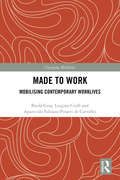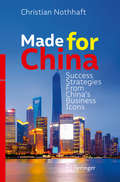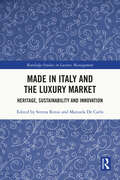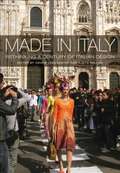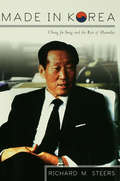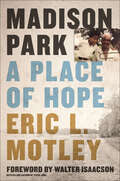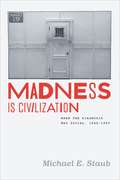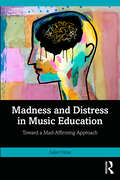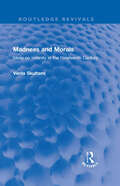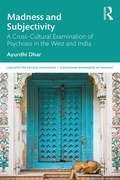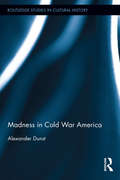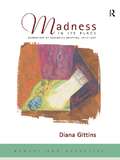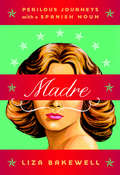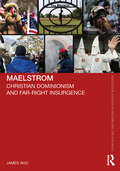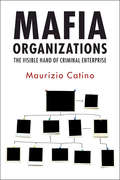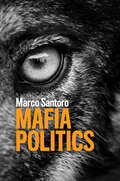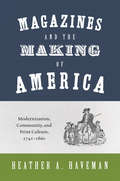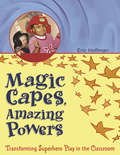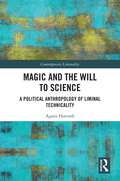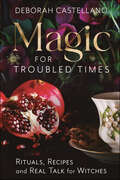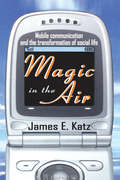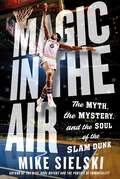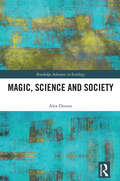- Table View
- List View
Made To Work: Mobilising Contemporary Worklives (Changing Mobilities)
by Luigina Ciolfi Breda Gray Aparecido Fabiano de CarvalhoMade to Work analyses the conditions of mobile knowledge work (MKW) in contemporary worklives, contrasting and drawing parallels among three highly significant sectors of the Knowledge Economy: academia, information communication technology (ICT) management, and digital creative work. It introduces the concept of ‘corollary work’ to characterise the elusive work underpinning the configuration of workers, informational, technological, relational and infrastructural resources in (re)producing liveable worklives. It ultimately illuminates the myriad strands of corollary work that enable MKW to take place and contributes to emergent debates on how exploitation, at least in the domain of MKW, can be named, resisted and creatively subverted. In so doing, it opens up a conversation about the complex ways in which contemporary worklives are ‘made to work’, and about potential interventions to bring about more just worklife conditions in the future.
Made for China
by Christian NothhaftThis book shares unique perspectives on the successful global evolution and future ambitions of Chinese consumer companies. It presents an unprecedented collection of one-on-one interviews with some of the most influential leaders in China, whose companies offer diverse products and services. Further, the book offers future business leaders encouragement and guidance on how to ride the consumer wave in China. It also investigates some of the foremost current trends, revealing the best opportunities for companies to succeed on the Chinese market. Written by a successful business leader, this book is a timely must-read for anyone seeking to understand Chinese consumers, the Chinese market and what makes Chinese entrepreneurs tick - helping them learn how to do business "Made for China".
Made in Italy and the Luxury Market: Heritage, Sustainability and Innovation (Routledge Studies in Luxury Management)
by Serena Rovai Manuela De CarloMade in Italy holds a highly significant position in the global luxury market, as an economic, cultural and social phenomenon and textbook example of the country-of-origin effect. Whilst in the past luxury was conceptualised as an exclusive benefit of the few, it is now a highly diversified ecosystem with disruptive challenges to its identity and authenticity, led by new customer segments. This book - through an analysis of diverse cases - answers the key issues in the industry of the new Made in Italy luxury, with a particular focus on sustainability. The book provides an in-depth view into luxury Made in Italy, from historical roots, heritage and tradition to major forces of change and innovative, entrepreneurial adaptations in the twenty-first century. It situates Made in Italy in the broader global context of change, with regards to the call for sustainable manufacturing and consumption. Written by an international pool of academics and experts in luxury brand management, the book presents a series of case studies to explore how the industry is responding to new consumer expectations and demand to maintain competitive advantage. This unique collection will be of interest for academics, scholars and upper-level students across the fields of luxury management and marketing, brand management, consumer behaviour as well as sustainability.
Made in Italy: Rethinking a Century of Italian Design
by Kjetil Fallan Grace Lees-MaffeiGoods made or designed in Italy enjoy a profile which far outstrips the country's modest manufacturing output. Italy's glorious design heritage and reputation for style and innovation has 'added value' to products made in Italy. Since 1945, Italian design has commanded an increasing amount of attention from design journalists, critics and consumers. But is Italian design a victim of its own celebrity? Made in Italy brings together leading design historians to explore this question, discussing both the history and significance of design from Italy and its international influence. Addressing a wide range of Italian design fields, including car design, graphic design, industrial and interior design and ceramics, well-known designers such as Alberto Rosselli and Ettore Sottsass, Jr. and iconic brands such as Olivetti, Vespa and Alessi, the book explores the historical, cultural and social influences that shaped Italian design, and how these iconic designs have contributed to the modern canon of Italian-inspired goods.
Made in Korea: Chung Ju Yung and the Rise of Hyundai
by Richard M. SteersAmerican business folklore is awash with the adventures of successful entrepreneurs. Still, most of these stories are about Americans, neglecting important and courageous entrepreneurs from other countries. Made in Korea recounts the story of how Chung Ju Yung rose from poverty to build one of the world's largest and most successful building empires - Hyundai - through a combination of creative thinking, tenacity, timing, political skills, and a business strategy that few competitors ever understood. Chung entered the shipbuilding business with no experience and went on to create the world's largest shipyard. He began making automobiles when foreign experts unanimously predicted he would fail, and he started a global construction company that has built some of today's greatest architectural wonders. He even convinced the International Olympic Committee to select South Korea over Japan as the site for the highly successful 1988 Olympics. Unlike most CEO's of major firms, Chung has always preferred the company of his workers to that of the global executive elite. Hard work, creativity and a capacity to never give up - this is the essence of Chung's life. In each of his ventures, he exhibited a sheer determination to succeed, regardless of the obstacles, and he worked tirelessly to instil this drive in all of his employees. Even today, in the midst of Korea's worst economic crisis in over four decades, Chung's company is busy implementing plans to emerge as an even stronger contender in the world economy. Illustrated with 32 pages of colour photographs not previously seen in the West, including photos of Chung's recent historic visit to North Korea in 1998, Made in Korea takes stock of Chung's entire life, highlighting both his contributions to society and the lessons his work can teach to aspiring entrepreneurs.
Made to Stick: Why Some Ideas Survive and Others Die
by Chip Heath Dan HeathWhat is that makes urban myths so persistent but many everyday truths so eminently forgettable? How do newspapers set about ensuring that their headlines make you want to read on? And why do we remember complicated stories but not complicated facts? In the course of over ten years of study, Chip and Dan Heath have established what it is that determines whether particular ideas or stories stick in our minds or not, and Made to Stick is the fascinating outcome of their painstaking research. Packed full of case histories and thought-provoking anecdotes, it shows, among other things, how one Australian scientist convinced the world he'd discovered the cause of stomach ulcers by drinking a glass filled with bacteria, and how a gifted sports reporter got people to watch a football match by showing them the outside of the stadium.
Madhyakalin Bharat Rajniti, Samaj Aur Sanskriti - Ranchi University, N.P.U: मध्यकालीन भारत राजनीति, समाज और संस्कृति - राँची यूनिवर्सिटी, एन.पी.यू.
by Satish Chandraमध्यकालीन भारत राजनीति, समाज और संस्कृति यह पुस्तक इतिहास के काल का वर्णन प्रस्तुत करती है, प्रस्तुत पुस्तक में विस्तार से इन अंतरों का पता लगाने की कोशिश किए बगैर आठवीं सदी से सत्रहवीं सदी की समाप्ति तक भारत के सामाजिक, आर्थिक, राजनीतिक और सांस्कृतिक प्रवृत्तियों के अभ्युदय के अध्ययन का प्रयास किया गया है । इन सभी पहलुओं को एक खंड में समायोजित करना कठिन काम था । इस कार्य के पीछे ध्येय यह रहा है कि पिछले चार दशकों में इतिहासकारों द्वारा मध्यकालीन भारतीय इतिहास को एक नई दिशा देने के प्रयासों को एक जगह लाने से इसके प्रति आम लोगों की दिलचस्पी बढ़ेगी । साथ ही, मध्यकालीन भारत में राज्य की प्रकृति, लोगों की धार्मिक स्वतंत्रता और उस अवधि में आर्थिक विकास की प्रवृत्ति को लेकर हाल में उठे विवादों को सही परिप्रेक्ष्य में देखा जा सकेगा । इस पुस्तक में यह दर्शाया गया है कि बड़े साम्राज्यों के अभ्युदय और फिर छोटे खंडों में विभाजन और एकीकरण का मतलब हमेशा आर्थिक निष्क्रियता और सांस्कृतिक ह्रास ही नहीं रहा है, भारतीय इतिहास के मध्यकाल की तुलना अकसर तुर्क और मुगल शासनकाल से की जाती है जिसका अर्थ है सामाजिक कारकों की जगह राजनीतिक कारकों को प्राथमिकता देना । यह अवधारणा इस मान्यता पर भी आधारित है कि पिछली कई सदियों के दौरान भारतीय समाज में बहुत थोड़ा बदलाव आया है । इतिहासकारों ने भारत में जनजातीय समाज के क्षेत्रीय राज्यों में तब्दील होने का मूल्यांकन किया है ।
Madison Park: A Place of Hope
by Eric L. MotleyIn this inspiring memoir, a former special assistant to President George W. Bush recounts the lessons he learned from his small Southern hometown.Welcome to Madison Park, a small community in Alabama founded by freed slaves in 1880. Eric Motley came of age in this remarkable place, where lessons in self-determination, hope, and an unceasing belief in the American dream taught him everything he needed for his life’s journey—a journey that led him to the Oval Office as a Special Assistant to President George W. Bush.Eric grew up among people who believed in giving and never turning away from a neighbor’s need. There was Aunt Shine, the goodly matriarch who cared so much about young Motley’s schooling that she would stand up in a crowded church and announce Eric’s progress—or shortcomings; Old Man Salery, who secretly siphoned gasoline from his beat-up car into the Motleys’ tank at night; Motley’s grandparents, who spent the last of their seed money on books for Eric; and Reverend Brinkley, a man of enormous faith and simple living. It was said that whenever the Reverend came your way, light abounded. Life in Madison Park wasn’t always easy or fair, and Motley reveals personal and heartbreaking stories of racial injustice and segregation. But Eric shows how the community taught him everything he needed to know about love and faith.
Madness Is Civilization
by Michael E. StaubIn the 1960s and 1970s, a popular diagnosis for America’s problems was that society was becoming a madhouse. In this intellectual and cultural history, Michael E. Staub examines a time when many believed insanity was a sane reaction to obscene social conditions, psychiatrists were agents of repression, asylums were gulags for society’s undesirables, and mental illness was a concept with no medical basis. Madness Is Civilization explores the general consensus that societal ills--from dysfunctional marriage and family dynamics to the Vietnam War, racism, and sexism--were at the root of mental illness. Staub chronicles the surge in influence of socially attuned psychodynamic theories along with the rise of radical therapy and psychiatric survivors' movements. He shows how the theories of antipsychiatry held unprecedented sway over an enormous range of medical, social, and political debates until a bruising backlash against these theories--part of the reaction to the perceived excesses and self-absorptions of the 1960s--effectively distorted them into caricatures. Throughout, Staub reveals that at stake in these debates of psychiatry and politics was nothing less than how to think about the institution of the family, the nature of the self, and the prospects for, and limits of, social change. The first study to describe how social diagnostic thinking emerged, Madness Is Civilization casts new light on the politics of the postwar era.
Madness and Distress in Music Education: Toward a Mad-Affirming Approach
by Juliet HessMadness and Distress in Music Education offers an in-depth exploration of mental health and emotional distress in the context of music education, offering new ways of thinking about these experiences and constructing ways to support distress through affirming pedagogy, practices, and policies in music education. Centering the lived experiences of 15 people in a range of roles across music education who self-identify an issue with their mental health, the volume addresses impacts on both students and educators. The author draws on Mad Studies and disability studies to present new paradigms for thinking about Madness and distress in the music context. An essential resource for music educators, music education researchers, and preservice students seeking to understand the complexities of mental health in the music classroom, this book considers how people conceptualize their mental health, how distress impacts participation in music education, how music education may support or exacerbate distress, and what supports for distress can be implemented in music education.
Madness and Morals: Ideas on Insanity in the Nineteenth Century (Routledge Revivals)
by Vieda SkultansFirst published in 1975, Madness and Morals presents the major preoccupations of nineteenth century society concerning insanity, its problems, and implications. In the introduction to the collection, Vieda Skultans traces developments and changes in the ideas about the insane and their treatment during the nineteenth century. She shows that two contrasting themes dominated writing on the subject: the relative weight to be attributed to physical and moral causes of insanity; and the emphasis on hereditary endowment or the ‘tyranny of organization’. The eighty years covered by this book produced a wide and varied literature on insanity, and the psychiatric texts reproduced, by English writers in the field are grouped under three sections: Outlines of Insanity; Psychiatric Romanticism; and Psychiatric Darwinism. These are written by physicians, administrators of the asylums and hospitals, editors of specialist publications, and others with wide experience in the field. These writings have a special relevance to the social history of the nineteenth century, for they demonstrate how psychiatric thinking reflects the contemporary moral outlook, forming a part of the total social fabric of society. This book will be useful for scholars and researchers of mental health, psychology, and psychiatry.
Madness and Subjectivity: A Cross-Cultural Examination of Psychosis in the West and India (Concepts for Critical Psychology)
by Ayurdhi DharThis crucial new work draws on empirical findings from rural North India in relation to madness and subjectivity, revealing the different structures of subjectivity underlying the narratives of schizophrenia, spirits, ghosts, and deities. Unravelling the loose ends of madness, the author explores the cultural differences in understanding and experiencing madness to examine how modern insanity is treated as a clinical disorder, but historically it represents how we form knowledge and understand self-knowledge. The author begins by theoretically investigating how the schizophrenic personifies the fractures in modern Western thought to explain why, despite decades of intense contention, the category of schizophrenia is still alive. She then examines the narratives of people in the Himalayan Mountains of rural India to reveal the discursive conditions that animate their stories around what psychology calls psychosis, critiquing the monoculturalism in trauma theory and challenging the ongoing march of the Global Mental Health Movement in the Global South. Examining what a study of madness reveals about two different cultures, and their ways of thinking and being, this is fascinating reading for students interested in mental health, critical psychology, and Indian culture.
Madness in Cold War America: Mad America (Routledge Studies in Cultural History)
by Alexander DunstThis book tells the story of how madness came to play a prominent part in America’s political and cultural debates. It argues that metaphors of madness rise to unprecedented popularity amidst the domestic struggles of the early Cold War and become a pre-eminent way of understanding the relationship between politics and culture in the United States. In linking the individual psyche to society, psychopathology contributes to issues central to post-World War II society: a dramatic extension of state power, the fate of the individual in bureaucratic society, the political function of emotions, and the limits to admissible dissent. Such vocabulary may accuse opponents of being crazy. Yet at stake is a fundamental error of judgment, for which madness provides welcome metaphors across US diplomacy and psychiatry, social movements and criticism, literature and film. In the process, major parties and whole historical eras, literary movements and social groups are declared insane. Reacting against violence at home and war abroad, countercultural authors oppose a sane madness to irrational reason—romanticizing the wisdom of the schizophrenic and paranoia’s superior insight. As the Sixties give way to a plurality of lifestyles an alternative vision arrives: of a madness now become so widespread and ordinary that it may, finally, escape pathology.
Madness in its Place: Narratives of Severalls Hospital 1913-1997 (Routledge Studies In Memory And Narrative)
by Diana GittinsThis fascinating study presents a unique history of psychiatry in the twentieth century. It brings together the memories and narratives of over sixty patients and workers who lived, or were employed, in Severalls Psychiatric Hospital, Essex, UK. Personal accounts are contextualised both in relation to wider developments and issues in twentieth-century mental health, and in relation to policies and changes in the hospital itself. Organised around the theme of space and place, and drawing upon both quantitative and qualitative material, chapters deal with key areas such as gender divisions, power relations, patterns of admission and discharge, treatments, and the daily lives and routines of patients and nurses of both sexes.
Madre: Perilous Journeys with a Spanish Noun
by Liza BakewellWhy is the word madre, "mother," so complicated in Spanish--especially in Mexico? Leaping off the page with energy, insight, and attitude, Liza Bakewell's exploration of language is anything but "just semantics." Why does me vale madre mean worthless, while !qué padre! means fabulous, she asks? And why do one hundred madres disappear when one padre enters the room, converting the group from madres to padres? Thus begins a journey through Mexican culture in all its color: weddings, dinner parties, an artist's studio, heart-stopping taxi rides, angry journalists, corrupt politicians, Blessed Virgins, and mothers both sacred and profane. Along the way, a reader discovers not only an invaluable lexicon of Mexican slang (to be used with caution or not at all) but also thought-provoking reflections on the evolution of language; its winding path through culture, religion, and politics; and, not least, what it means--and what it threatens--to be a creative female, a madre.
Maelstrom: Christian Dominionism and Far-Right Insurgence (Routledge Studies in Fascism and the Far Right)
by James AhoMaelstrom: Christian Dominionism and Far-Right Insurgence illuminates the latest outbreak of right-wing extremism in America. This book reviews the cyclical nature of right-wing resurgences in American history, dismisses the appropriateness of the word “fascism” to explain them, and then describes in depth the goal of “reconstructing” American institutions on the basis of biblical principles. It critiques the popular view that far-right politics is carried by stupid, socially isolated, nuts. To this end, it discusses the logicality of the “big lie” and examines in detail how people are recruited into the far-right, by entertaining the theories of authoritarianism and resource mobilization. Finally, it characterizes how the ends-oriented rationality of far-right activists differs from the mini-max criterion of rationality utilized by the ordinary person. This can motivate them to be violent and can frustrate efforts by the government to control them.
Mafia Organizations: The Visible Hand of Criminal Enterprise
by Maurizio CatinoHow do mafias work? How do they recruit people, control members, conduct legal and illegal business, and use violence? Why do they establish such a complex mix of rituals, rules, and codes of conduct? And how do they differ? Why do some mafias commit many more murders than others? This book makes sense of mafias as organizations, via a collative analysis of historical accounts, official data, investigative sources, and interviews. Catino presents a comparative study of seven mafias around the world, from three Italian mafias to the American Cosa Nostra, Japanese Yakuza, Chinese Triads, and Russian mafia. He identifies the organizational architecture that characterizes these criminal groups, and relates different organizational models to the use of violence. Furthermore, he advances a theory on the specific functionality of mafia rules and discusses the major organizational dilemmas that mafias face. This book shows that understanding the organizational logic of mafias is an indispensable step in confronting them.
Mafia Politics
by Marco SantoroThis ground-breaking book offers a deep and original analysis of the Mafia – in particular Cosa Nostra – as a distinct form of politics. Marco Santoro breaks with criminal and economic approaches which see the Mafia as an industry of private protection and rationally calculating wealth accumulation. Instead he argues that it represents an alternative way of organizing political relations, the exercise of power, and the struggle for prestige. Nor is this a distortion or failure of the modern Western state, based on the rule of law: the Mafia is best understood as an older, alternative tradition of politics, a distinctly Southern institutional arrangement of social life focused on personal ties and obligations. Today, the Mafia still thrives among subaltern classes and in regions that the modern state has not yet incorporated, as a conservative counter-politics of prestige. Pivotal to understanding this world is a cultural sociology of the Mafia, offering the tools and concepts necessary to penetrate the symbolism and structures of Mafia life. Blending diverse theoretical strands with folk sources and the voices of Mafiosi themselves, Santoro develops a political theory of the Mafia, shedding new light on this captivating, global, and remarkably resilient phenomenon.
Magazines and the Making of America: Modernization, Community, and Print Culture, 1741-1860
by Heather A. HavemanFrom the colonial era to the onset of the Civil War, Magazines and the Making of America looks at how magazines and the individuals, organizations, and circumstances they connected ushered America into the modern age. How did a magazine industry emerge in the United States, where there were once only amateur authors, clumsy technologies for production and distribution, and sparse reader demand? What legitimated magazines as they competed with other media, such as newspapers, books, and letters? And what role did magazines play in the integration or division of American society? From their first appearance in 1741, magazines brought together like-minded people, wherever they were located and whatever interests they shared. As America became socially differentiated, magazines engaged and empowered diverse communities of faith, purpose, and practice. Religious groups could distinguish themselves from others and demarcate their identities. Social-reform movements could energize activists across the country to push for change. People in specialized occupations could meet and learn from one another to improve their practices. Magazines built translocal communities--collections of people with common interests who were geographically dispersed and could not easily meet face-to-face. By supporting communities that crossed various axes of social structure, magazines also fostered pluralistic integration.Looking at the important role that magazines had in mediating and sustaining critical debates and diverse groups of people, Magazines and the Making of America considers how these print publications helped construct a distinctly American society.
Magic Capes, Amazing Powers
by Eric HoffmanHeroes, villains and saving the day! Magic Capes, Amazing Powers explores why children are so strongly attracted to superhero and weapons play, and addresses the resulting concerns of parents and teachers. Unique in its approach to this wildly popular type of play, Magic Capes describes how teachers can use redirection, story-telling, dramatic play materials, anti-bias curriculum and clear limit-setting to guide superhero play in a positive direction that allows children to play and satisfies the concerns of adults.Eric Hoffman is the program coordinator for the Cabrillo College Children's Center in Aptos, CA. He has worked with preschool-age children since 1970 and cofounded the CRADLE Project, which assists teachers and parents who do conflict resolution with children.
Magic and the Will to Science: A Political Anthropology of Liminal Technicality (Contemporary Liminality)
by Agnes HorvathThis book offers a political anthropological perspective on the problematic character of science, combining insights from historical sociology, political theory, and cultural anthropology. Its central idea, departing from the works of Frances Yates and the Gnosticism thesis of Eric Voegelin, is that far from being the radical opposite of magic, modern science effectively grew out of magic, and its varieties, like alchemy, Hermetic philosophy, the occult, Gnosticism, and Neoplatonism. Showing that the desire to use science to solve various – real or presumed – problems of human existence has created a permanent liminal crisis, it contends that the ‘will to science’ is parasitic, existing as it does in sheer relationality, outside of and in between concrete places and communities. A study of the mutual relationship between magic and science in different historical eras, ranging from the Early Neolithic to recent disease prevention ideas, Magic and the Will to Science will appeal to scholars and students of social and anthropological theory, and the philosophy and sociology of science.
Magic for Troubled Times: Rituals, Recipes, and Real Talk for Witches
by Deborah CastellanoSpells, Rituals, and Guidance for Your Transformative Journey through Troubled TimesMagic is always possible, even when it's hard to see. No matter what you're struggling with, this book can help you overcome it. Featuring gentle ways to recover and a magical plan of action, Magic for Troubled Times gives you the courage to reach the joyful times in your future.Deborah Castellano sits you down for some real talk on how to navigate difficult waters, whether you're facing a pandemic or a messy breakup. She first helps you get back on your feet, and then she guides each step forward with grounding and healing exercises, protection and money spell work, delicious recipes, and more. From luck and glamour magic to offerings and hexing, this book is full of useful strategies for both getting through the roughest parts of life and making each day better.
Magic in the Air: Mobile Communication and the Transformation of Social Life
by James E. KatzIn this timely volume, James E. Katz, a leading authority on social consequences of communication technology, analyzes the way new mobile telecommunications affect daily life both in the United States and around the world. Magic in the Air is the most wide-ranging analysis of mobile communication to date. Katz investigates the spectrum of social aspects of the cell phone's impact on society and the way social forces affect the use, display, and re-configuration of the cell phone. Surveying the mobile phone's current and emerging role in daily life, Katz finds that it provides many benefits for the user, and that some of these benefits are subtle and even counter-intuitive. He also identifies ways the mobile phone has not been entirely positive. After reviewing these he outlines some steps to ameliorate the mobile phone's negative effects. Katz also discusses use and abuse of mobile phones in educational settings, where he finds that their use is eroding students' participation in class even as it is helping them to cheat on exams and cut class. Parents no longer object to their children having mobile phones in class in a post-Columbine and 9/11 era; instead they are pressing schools to change their rules to allow students to have their phones available during class. And mobile phone misbehavior is by no means limited to students: Katz finds that teachers are increasingly taking calls in the middle of class, even interrupting their own lectures to answer what they claim are important calls. In keeping with the book's title, Katz explores the often overlooked psychic and religious uses of the mobile phone, an area that has only recently begun to command scholarly interest. Magic in the Air will be essential reading for communications specialists, sociologists, and social psychologists.
Magic in the Air: The Myth, the Mystery, and the Soul of the Slam Dunk
by Mike Sielski"Who doesn't wanna read an entire book about the slam dunk? I love basketball." - Ann Patchett "The definitive dunking dissertation." - Jack McCallum, Wall Street JournalFrom the author of the bestselling Kobe Bryant biography The Rise comes the legend of the most powerful shot in basketball: the slam dunk.The evolution of basketball, and much of the social and cultural change in America, can be traced through one powerful act on the court: the slam dunk. The dunk's history is the story of a sport and a country changed by the most dominant act in basketball, and it makes Magic in the Air a rollicking and insightful piece of narrative history and a surefire classic of sports literature.When basketball was the province of white men, the dunk acted as a revolutionary agent, a tool for players like Wilt Chamberlain and Bill Russell to transform the sport into a Black man’s game. The dunk has since been an expression of Black culture amid the righteous upheaval of the civil-rights movement, of the threat that Black people were considered to be to the establishment. It was banned from college basketball for nearly a decade—an attempt to squash the individual expression and athleticism that characterized the sport in America’s cities and on its playgrounds. The dunk nevertheless bubbled up to basketball’s highest levels. From Julius Erving to Michael Jordan to the high flyers of the 21st century, the dunk has been a key mechanism for growing the NBA into a global goliath.Drawing on deep reporting and dozens of interviews with players, coaches, and other hoops experts, Magic in the Air brings to life the tale of the dunk while balancing sharp socio-racial history and commentary with a romp through American sports and culture. There's never been a basketball book quite like it.
Magic, Science and Society (Routledge Advances in Sociology)
by Alex DennisMagic, Science and Society investigates the way the ‘rationality debate’ has developed over the last century, from E.E. Evans-Pritchard’s study of Azande magic, through Peter Winch’s argument that there can be no such thing as a social science, across the arguments about the proper status of science in the 1970s and 1980s, to the ‘epistemological’ and ‘ontological’ turns of the early twenty-first century.Different people have different understandings of what is rational: some practise magic, some orientate to legal convention and tradition and others defer to science and logic. Starting with anthropological studies of witchcraft, and working through to contemporary debates about epistemology and ontology in social science, this book systematically examines the ways key questions about these issues have been framed and answered. These include: Can ‘magic’ be real, either for members of the cultures that practise it or more generally? How can we arbitrate between different types of rationality? Is science a benchmark for studying other forms of rationality or just a cultural practice like any other? What are the implications of these issues for the social sciences themselves? This book will be of interest to anthropologists, sociologists, philosophers of the social sciences and science studies practitioners.
